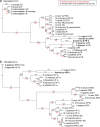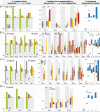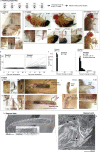A conserved strategy for inducing appendage regeneration in moon jellyfish, Drosophila, and mice
- PMID: 34874003
- PMCID: PMC8782573
- DOI: 10.7554/eLife.65092
A conserved strategy for inducing appendage regeneration in moon jellyfish, Drosophila, and mice
Erratum in
-
Correction: A conserved strategy for inducing appendage regeneration in moon jellyfish, Drosophila, and mice.Elife. 2023 Jun 22;12:e90007. doi: 10.7554/eLife.90007. Elife. 2023. PMID: 37347509 Free PMC article.
Abstract
Can limb regeneration be induced? Few have pursued this question, and an evolutionarily conserved strategy has yet to emerge. This study reports a strategy for inducing regenerative response in appendages, which works across three species that span the animal phylogeny. In Cnidaria, the frequency of appendage regeneration in the moon jellyfish Aurelia was increased by feeding with the amino acid L-leucine and the growth hormone insulin. In insects, the same strategy induced tibia regeneration in adult Drosophila. Finally, in mammals, L-leucine and sucrose administration induced digit regeneration in adult mice, including dramatically from mid-phalangeal amputation. The conserved effect of L-leucine and insulin/sugar suggests a key role for energetic parameters in regeneration induction. The simplicity by which nutrient supplementation can induce appendage regeneration provides a testable hypothesis across animals.
Keywords: D. melanogaster; appendage regeneration; evolutionary biology; insulin; leucine; limb regeneration; moon jellyfish; mouse; regenerative medicine; stem cells; sucrose.
Plain language summary
The ability of animals to replace damaged or lost tissue (or ‘regenerate’) is a sliding scale, with some animals able to regenerate whole limbs, while others can only scar. But why some animals can regenerate while others have more limited capabilities has puzzled the scientific community for many years. The likes of Charles Darwin and August Weismann suggested regeneration only evolves in a particular organ. In contrast, Thomas Morgan suggested that all animals are equipped with the tools to regenerate but differ in whether they are able to activate these processes. If the latter were true, it could be possible to ‘switch on’ regeneration. Animals that keep growing throughout their life and do not regulate their body temperatures are more likely to be able to regenerate. But what do growth and temperature regulation have in common? Both are highly energy-intensive, with temperature regulation potentially diverting energy from other processes. A question therefore presents itself: could limb regeneration be switched on by supplying animals with more energy, either in the form of nutrients like sugars or amino acids, or by giving them growth hormones such as insulin? Abrams, Tan, Li et al. tested this hypothesis by amputating the limbs of jellyfish, flies and mice, and then supplementing their diet with sucrose (a sugar), leucine (an amino acid) and/or insulin for eight weeks while they healed. Typically, jellyfish rearrange their remaining arms when one is lost, while fruit flies are not known to regenerate limbs. House mice are usually only able to regenerate the very tip of an amputated digit. But in Abrams, Tan, Li et al.’s experiments, leucine and insulin supplements stimulated limb regeneration in jellyfish and adult fruit flies, and leucine and sucrose supplements allowed mice to regenerate digits from below the second knuckle. Although regeneration was not observed in all animals, these results demonstrate that regeneration can be induced, and that it can be done relatively easily, by feeding animals extra sugar and amino acids. These findings highlight increasing the energy supplies of different animals by manipulating their diets while they are healing from an amputated limb can aid in regeneration. This could in the future pave the way for new therapeutic approaches to tissue and organ regeneration.
© 2021, Abrams et al.
Conflict of interest statement
MA, FT, TB, MH, LG Inventor in patent rights application for findings in the manuscript, YL, AS, IL, ZC, MR, JD, DG No competing interests declared
Figures



















Comment in
-
Response to comment on 'A conserved strategy for inducing appendage regeneration in moon jellyfish, Drosophila, and mice'.Elife. 2023 Jun 22;12:e85370. doi: 10.7554/eLife.85370. Elife. 2023. PMID: 37347515 Free PMC article.
-
Comment on 'A conserved strategy for inducing appendage regeneration in moon jellyfish, Drosophila, and mice'.Elife. 2023 Jun 22;12:e84435. doi: 10.7554/eLife.84435. Elife. 2023. PMID: 37347531 Free PMC article.
References
-
- Borenstein M, Hedges LV, Higgins JPT, Rothstein HR. Introduction to Meta-Analysis. Chichester, UK: John Wiley & Sons, Ltd; 2009. - DOI
Publication types
MeSH terms
LinkOut - more resources
Full Text Sources
Molecular Biology Databases
Miscellaneous

